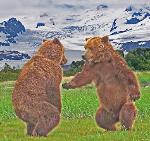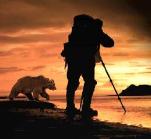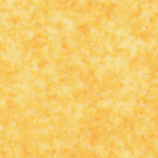| Bear Viewing Association To watch, to wonder, and to conserve [email protected] Ph/Fax (907) 260-9059 (Office) 39200 Alma Ave. Soldotna, AK 99669 |


| The South Fork flows out of the eastern leg of Double Glacier. The North fork is fed by several other glaciers. Most of these glaciers cling to the slopes of Mt. Mastadon. |
| Glaciers, Glacial Landscapes, and Their Roles in the Ecology of Alaskan Bears |









The Chigmiut Mountain Range, rising just west of Otter Lake, are covered with one of the largest ice fields in Alaska, and thus in North America. In
some areas, the ice is hundreds of feet deep, covering all but the tallest peaks. Ice caps, such as the one covering most of Greenland, are even
larger expanses of ice -- up to 50,000 sq. km in area. Largest of all are ice shields or sheets, such as the one which covered the upper half of
North America during the last Ice Age, or the one still covering most of Antarctica.
some areas, the ice is hundreds of feet deep, covering all but the tallest peaks. Ice caps, such as the one covering most of Greenland, are even
larger expanses of ice -- up to 50,000 sq. km in area. Largest of all are ice shields or sheets, such as the one which covered the upper half of
North America during the last Ice Age, or the one still covering most of Antarctica.


The upper slopes of Mt. Mastadon are covered with a fairly smooth cap of ice
and snow, as shown below. But rest of the mountain is as jagged as the teeth
of a mastadon (hence the name), as is especially obvious if you fly over, for
instance in a helicopter tour (above) through the nearby Redoubt Bay Lodge.
and snow, as shown below. But rest of the mountain is as jagged as the teeth
of a mastadon (hence the name), as is especially obvious if you fly over, for
instance in a helicopter tour (above) through the nearby Redoubt Bay Lodge.
Wooly mammoth
Mastadon
| The mammoth was a grazer. Crushing grass doesn't require sharply serrated molars. But such teeth are needed to grind woody vegetation into pulp -- the preferred diet of the mastadon. |


Glaciers & glacial landscapes near Wolverine Creek
Ice glaciers and stone glaciers
Glaciers and Crevasses: What are they and how do
they form?
Glacial land forms.
Ice glaciers and stone glaciers
Glaciers and Crevasses: What are they and how do
they form?
Glacial land forms.
Moraines
Aquatic glacial ice shelves and ice bergs.
Ice Age Cook Inlet
Periglacial low altitude landscapes
Glaciers, volcanoes, salmon and bears - an
ecological web bears.
Aquatic glacial ice shelves and ice bergs.
Ice Age Cook Inlet
Periglacial low altitude landscapes
Glaciers, volcanoes, salmon and bears - an
ecological web bears.
Glaciers & glacial landscapes near Wolverine Creek
Ice glaciers and Stone Glaciers
Site Visit Counter


